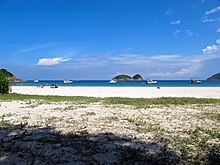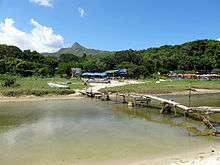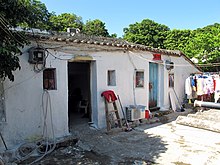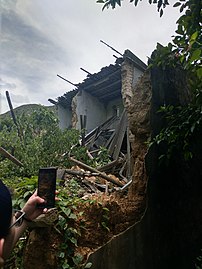Ham Tin
Ham Tin (鹹田)
a village in Pui O, Lantau Island
Ham Tin Tsuen (鹹田村)
a village in Tai Wo Hau, Kwai Chung
Ham Tin Shan (鹹田山)
the former name of Lam Tin
Ham Tin (鹹田)



Geography
Ham Tin is located in Eastern Sai Kung. There are four villages with over 200 years of development in Tai Long Wan including Tai Long Village, Lam Uk Wai, Cheung Uk Wai and Ham Tin Village. However, only Tai Long Village and Ham Tin Village still exist and the other two had already been abandoned and became ruins.
Ham Tin area has a typical rural landscape, surrounded by mountains, and one main river directly flowing to Ham Tin Wan, which is one of the four bays forming the beautiful Tai Long Wan.
History
Tai Long Village, Lam Uk Wai, Cheung Uk Wai and Ham Tin Village are the four old villages in Ham Tin. According to the survey conducted by Antiquities and Monuments Office, the villages have more than 200 years of history and about 90% of the village houses have more than 100 years of history. The genealogy of the Li family of Tai Long Sai Wan mentions that their ancestors settled in Tai Long Wan and the surrounding areas during the period from 1465 to 1487. There were about 600 to 700 villagers living in 10 surnames, including Zhan, Zhang, Li, Dai, Kong, Lin, etc.
For Tai Long Village, it was the largest in scale among the four villages so the village office was set up there. It is lucky to see that there is a village that still retains the traditional architectural structure so completely in Hong Kong. For Ham Tin Village, the surname of the villagers is mainly in Wan. The villagers have stayed in Ham Tin for 7 to 8 generations and most of the buildings were built in the pre-war period. Lam Uk Wai and Cheung Uk Wai were on a smaller scale so they have been left abandoned, and part of them was covered by plants for a period of time.
The four villages were once a big village group and the villagers were mainly farmers and fishermen. Most of the villagers moved out to the urban area to make a better living during the industrial development period of Hong Kong since there was a lack of job opportunities in the villages and the transportation was inconvenient. Along with the lower population, the villages became deserted.
Religion
Started from the 1860s, Catholic missionaries entered the villages and assisted villagers. They provided assistances and helping hands that improved the livelihood of villagers, including offering material and medical help. In the nineteenth century, malaria and smallpox were critical diseases which threatened the life of people, especially kids. The missionaries helped in the prevention of these diseases. This contribution spectacularly is an example to show that the missionary work was beneficial for residents of villages. Apart from providing medical treatments to the residents, they also offered some necessaries such as food to the residents. After building up a good relationship with the residents, the missionaries tried to spread religious belief and practices among the village. The villagers were grateful for their work and most of them were baptized as Catholic. A religious atmosphere was gradually spread through the village in this period of time. A Catholic Church of The Immaculate Conception which was rebuilt in 1931 was used for teaching, worshiping and religious ceremonies. A Sister House was built nearby the church so that the sisters can visit and live among the villagers with convenience. Missionaries were also responsible for holding weddings when couples got married and funerals when someone died.
Villages
Ham Tin Village
Ham Tin Village is one of the villages in the area of Tai Long in Sai Kung East, facing Tai Long Wan. In the past, the people in Tai Long mainly relied on fishing and farming (e.g. rice and sugarcane) to earn a living. Lives were simple and tough; many of them walked 4 or 5 hours to Ngai Chi Wan in order to sell their crops and fish. Some of them transported timber to Shau Kei Wan and Aberdeen by boat and sold them in exchange for daily necessities. Today, Tai Long still has not had a ferry pier. Ham Tin Tsuen is believed to have a history of over 150 years. The village has been inhabited by the Wan clan for about 7 or 8 generations. The Wans moved from northern China and settled in Tai Nam Wu, Sai Kung, long time ago. About 150 years ago, three Wan brothers from Tai Nam Wu spread out and settled in different areas in the New Territories---one settled in Tai Po Chai, another in Ho Chung, and the third one in Ham Tin Tsuen in Sai Kung. It is believed that the one who settled in Ham Tin Tsuen was the founding ancestor of the village. Many villagers have emigrated to Britain and there are only less than 10 villagers in total.
Tai Long Village

Tai Long Village is the oldest village in the area of Tai Long in Sai Kung East, facing Tai Long Wan. In the past, the people in Tai Long mainly relied on fishing and farming (e.g. rice and sugarcane) to earn a living. Lives were simple and tough; many of them walked 4 or 5 hours to Ngai Chi Wan in order to sell their crops and fish. Some of them transported timber to Shau Kei Wan and Aberdeen by boat and sold them in exchange for daily necessities. Today, Tai Long still has not had a ferry pier. Tai Long Tsuen has a history of over 250 years. The villagers are of several surnames, namely, Chan, Cheung, Cham, Tai, Lai and Ngai. The ancestor of the Cham clan, Cham Kai-ming, came from Xintang in Guangdong province and settled in Tai Long Tsuen during the Qing Dynasty. Xin’an County Gazetter records that Tai Long Village came under the management of Guanfu magistrate. Nowadays, many villagers in Tai Long Tsuen have emigrated to Britain and there are only less than 10 villagers in total.
Important Buildings
Immaculate Conception Chapel (聖母無原罪小堂)

Immaculate Conception Chapel, originally founded in 1867 and named Holy Family Chapel, is one of the Catholic churches that is located in eastern New Territories. It was recognized as a Grade III historical building in Hong Kong.
At the beginning, many of the indigenous were fishermen and they believed in Tin Hau. Missionaries then arrived at Sai Kung and offered help to the villagers. For 6 years of time, the number of followers has rapidly increased, therefore, the church was rehabilitated and it has expanded its capacity to hold about 200 to 300 people, which was one third of the original capacity.
In the 1950s, the population of the villages was at its peak of 600 to 700 villagers, and over 500 people were Catholics. The church had become the largest Catholic church in the area, which had the greatest number of followers in Sai Kung. Therefore, Tai Long Village was once regarded as one of the missionary bases in earlier Hong Kong.
The existing chapel was built in 1931 and was renamed as Immaculate Conception Chapel in 1954 under the management of another Holy Family Chapel in Chek Keng. In 1979, Hong Kong was attacked by the typhoon, Hope, and the chapel was damaged again. The diocese then decided to renovate the chapel and demolish the original clock tower. However, villagers have started to move out to urban areas or immigrate overseas since the 1960s and the number of followers going to the chapel kept decreasing. The chapel was reopened in 1981 and closed in 1988 at last.
But still, whenever a Catholic of the village passes away, priests will return to the chapel and host a mass for them.
Yuk Ying School
It is the only primary school in the village that is located next to the Immaculate Conception Chapel and was closed together with the chapel in 1988.
In the past, it was inconvenient to transport to the city centre. To educate the children in the villages, who could not go to schools in the urban city, the Yuk Ying School was set up during the early post-war period in Hong Kong, under the assistance of missionaries. Later on, the number of students studying in the school was reduced gradually due to the reduced population in the villages, and the school has stopped its service since 1988.